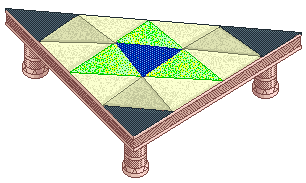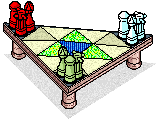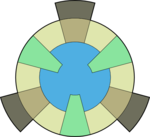Taasen
Taasen: The Game Of Tryslmaistan Chess
Taasen is a board game from the Unicorn Jelly comic by Jennifer Diane Reitz.
It is played on a triangular board subdivided into 16 smaller triangles.
This page covers several Taasen topic...
Contents |
Making a board
An awesome coffee-table sized Taasen board should be...
- Approx 60cm per side (15cm per side per space) and 30/45cm high
- The top be reversible to show two board styles (trad and 'clock')
- The legs attach to the top magnetically
- "Glom" legs of acrylic, LEDs to make glow. Battery powered?
- Magnetic pieces for awesome stability.
- Also, pieces can be stored "upside down" under the table.
Online Play
Secondly, we will now attempt to describe methods to exchange and record a board setup and the moves of a game.
Why?
- Facilitate play-by-email (or icq, irc, etc ;)
- To log games for later examination
First up, let us number the positions.
- Numbered 1 through 16
- Orientate the board so the starting corner is pointing "up"left to right in 4 horizontal rows from top to bottom.(this means that on odd-numbered rows, the odd numbered positions are triangles pointing up, while on even numbered rows, it is hte even numbered positions that point "up")
- Corners are number 1, 10 and 16
- Center sea is 7
- Green land around the sea is 6, 8 and 13
(Note that an alternate numbering position could be made whereby there are 7 rows, with each row being made only of "up" or "down" triangles, alternating in styles per row. However this is not as visually obvious to me. Either style is equally usable, so long as players are aware of the differences. In this style, Corners are 1, 13, 16. Central Sea is 8, and green surround is 5, 6 and 11)
Since the board is triangular, there is no tactical advantage to any colour starting at any specific corner. The alignment of starting corners to players is given at the start of the game record. (if we start a record in mid-game, then the matter is irrelevant anyways)
Secondly, identifying the pieces
Players
- R = Red piece/player
- G = Green piece/player
- W = White piece (neutral player can be controlled by either side)
Pieces
- T = Thaum (triangle within circle)
- S = Sciane (circle with four exterior spokes - a cog)
- P = Paupil (unadorned circle)
Thus, each piece is identified by their two-letter code, for example...
- RS = Red Sciane
- RT = Red Thaum
- WT = White Thaum
- GP = Green Paupil
Next, how do we show the initial piece positions?
A position is shown by giving that piece code, and then =number for the position the piece is on.
For eg, a starting configuration might be
- WT=1, WS=1, WT=1, RS=10, RT=10, RP=10, GS=16, GT=16, GP=16
Finally, how do we show movements, pushes and crushes?
To show a movement, we simply give the piece code, and then the position number that it has moved to. (ie, just like a position statement, but without the "=")
- A push move is shown enclosed in parenthesis (and also can be given on the same line as the "pushing" move - especially if there is only one location for the piece to be moved to, in which case the pusher can cite the push. Otherwise table talk to remove the pushed player that they need to choose a location to be pushed to.
- A crush is also in parenthesis, but instead of a location following the piece identifier, it is preceeded by an exclamation (common computerese for a negation) or an "x" (so it reads as "ex-piece", eg (xRS) would be "ex red sciane"). Alternatively, a non-legal position could be given in regular format (eg: WP0 or GT17)
An example in practice...
- The Setup
- GT=6, RP=10, RS=11, GS=12
- Thaum Moves
- GT5
- Sciane is pushed and crushed
- (xRS)
In a game log, the move and the push or crush would be shown on the same line. (as noted above, in play, the pushed move may need to be made by the pushed player.
- GT5 (xRS)
Taasen and all images on this page to note are copyright Jennifer Diane Reitz
Alternative board topologies and analogies
Taasen board topology is not tied to the triangle. The board has 15 playable areas - which can be represented by a circle of 12 parts, with three additional locations equally located 'outside' every fourth spot. Additionally, the locations midway between those on the main ring are 'linked' (the "green" spots). Whilst topologically identical, might the alternative board layout may have an effect on the psychology of players and tactics used? Additionally, this topology would encourage a third numbering scheme - 'clock' style, with corners assigned simply as A, B, C (being outside positions 4, 8 and 12, whilst the 'linked' spots are positions 2, 6 and 10, or reverse). The important thing is that all players agree on named topology beforehand! :)
Another way to view the game of Taasen, perhaps an easier way for those Mundis in earth western culture, is as a board game version of rock scissors paper. Indeed, we can make the following analogies - that approximately work...
| type | item | item | item |
|---|---|---|---|
| Roshambo | Rock | Scissors | Paper |
| materials | earth/stone | metal | wood |
| 3d object | pyramid | cog | disc |
| Taasen | Thaum | Sciane | Paupil |
| Taasen represents | Religion | Science | Population |



